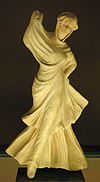Tanagra (Gérôme sculpture)
In December 1870, at a site called Tanagra in Greece, archaeologists unearthed a group of Hellenistic terra cotta figurines bearing traces of original polychrome.Tanagra figurines infiltrated popular literature and theater, as seen by references in Oscar Wilde's The Picture of Dorian Gray (1891) and An Ideal Husband (1895), and Marcel Proust's Swann's Way (1913).His famous images of gladiator combats, chariot races, slave markets, the assassination of Julius Caesar, and other subjects from ancient Greece and Rome were widely influential."[3] "Inspired by his characteristic desire for both archaeological accuracy and realism, Gérôme delicately tinted the skin, hair, lips, and nipples of his Tanagra, causing a sensation at the Salon of 1890."[4] A contemporary critic suggested that if the sculpture had been "secretly buried for a time, and then publicly excavated as an antique, perhaps with a broken arm, it would have turned the heads of the whole art world, and been declared in its vital characteristics and subtle anatomy a rival to the Milo Venus.Also in this painting, the young artisan is busy "colouring an edition of 12 Hoop Dancers in various brilliant hues—a tongue-in-cheek advertisement, perhaps, made to promote the figurines that he [Gérôme] was offering for sale in two different sizes and a variety of media through his dealer and father-in-law Adolphe Goupil."[4] As in all his works connected to Tanagra, we see Gérôme "powerfully evoking the continuous interplay between painting and sculpture, reality and artifice, as well as highlighting the inherently theatrical nature of the artist’s studio.




Jean-Léon GérômeMusée d'OrsayTanagra figurinesParis SalonClassical antiquitydoppelgängersLouvreTanagraExposition Universelle of 1878Oscar WildeThe Picture of Dorian GrayAn Ideal HusbandMarcel ProustSwann's WayHaggin MuseumArt Gallery of OntarioSotheby'sÉcole des Beaux-ArtsEmma DoupontDahesh Museum of ArtPygmalion and GalateaMetropolitan Museum of ArtEmma DupontPygmalionGalateaLéopold Bernhard BernstammMusée Georges-GarretVesoulPhoenix Art MuseumPygmalion and Galatea (Gérôme painting)The Cock FightThe Duel After the MasqueradePhryne Before the AreopagusCleopatra and CaesarThe Slave MarketThe Death of CaesarJerusalemThe Execution of Marshal NeyBashi-BazoukPrayer in the MosquePollice VersoReception of the Grand Condé at VersaillesThe Snake CharmerA Chat by the FiresideThe Tulip FollyThe Christian Martyrs' Last PrayerSlave Market in Ancient RomeBonaparte Before the SphinxBathshebaThe Birth of VenusTruth Coming Out of Her WellOmphaleList of pupils